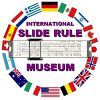About the author: Hilary Lew wrote several articles and reviews about Taiwan (Republic of Taiwan) culture in the 1960's and 1970's. These writings can be found in the Taiwan Today and Taiwan Info (National Government) Archives.
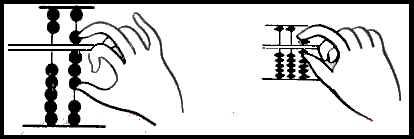
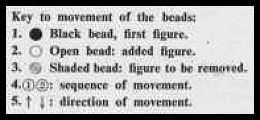
Chinese Vs Japanese Method of moving the beads.
The abacus is the fastest calculating machine ever devised by man. It has surpassed electric computers in several international contests, yet remains one of the simplest mathematical aids in both construction and use.
Invented in ancient China, it has become popular wherever the written Chinese language is used and is an indispensable instrument of cashiers, Accountants, merchants, and statisticians. Farmers click off their crop situation, housewives the family accounts, teachers their classes' grade averages. The adding machine of the West is rarely found outside commercial establishments; the abacus is ubiquitous.
A Chinese abacus has from 9 to 17 vertical strings or reeds on which the beads are strung. A barrier runs across the strings, dividing the abacus into upper and lower sections. Each of the reeds is strung with seven button-like beads, two in the upper section and five in the lower. The two beads in the upper section have a value of 5 each; the five in the lower section have values of 1 each. An average abacus weighs two pounds and the most common have 13 strings.
Old Japanese models have six beads on each reed, one in the upper section and five in the lower. A newer design has four beads in the lower section. They are about half the size of the Chinese abacus and weigh less than a pound. The most common have 21 or 27 reeds.
To facilitate multiplication, division, and extraction of square and cubic roots, Prof. Lee Kai-chen of the Tamkang College of Arts and Sciences in Taipei recently combined the seven-bead Chinese and the five-bead Japanese models into a single device.
An abacus is made of wood. Ebony is considered ideal.
The Chinese use the thumb, index, and middle fingers, of the right hand to operate the abacus. The Japanese do not use the middle finger.
In manipulating the Chinese abacus, the thumb controls the upward movement of the lower beads. The index finger controls the downward movement of the lower beads. The middle finger controls the downward and upward movements of the upper beads.
For the Japanese abacus, the thumb controls the upward movement of the lower beads. The index finger controls the upward and downward movement of the upper beads and the downward movement of the lower beads.
Before beginning a calculation, the operator moves the upper' beads against the upper frame and the lower beads against the lower frame, leaving open space along both sides of the framework dividing the abacus into upper and lower sections. When a lower bead is moved up to the barrier, the value is 1. When an upper bead is lowered, the value is 5. The operator reads the beads from left to right.
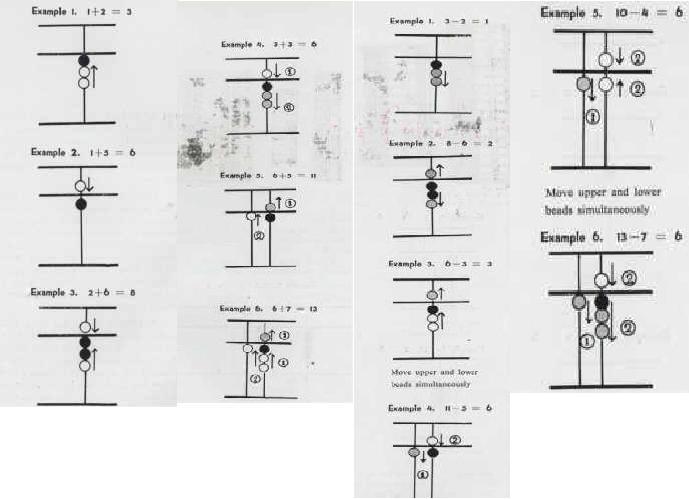
As in arithmetic, the beginner starts with addition, then progresses to subtraction, multiplication, and division. To add, it is only necessary to manipulate beads corresponding to the integers of the problem. Calculations may begin anywhere on the abacus. Addition usually is carried out in the middle area.
Subtraction is carried out in the reverse order of addition. Beads corresponding to the subtrahend (or number subtracted) will be removed from the minuend (or the number that is being subtracted from).
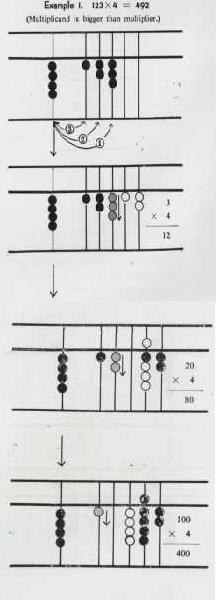
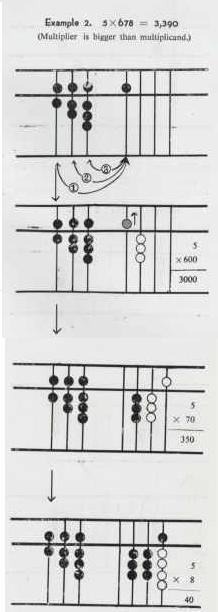

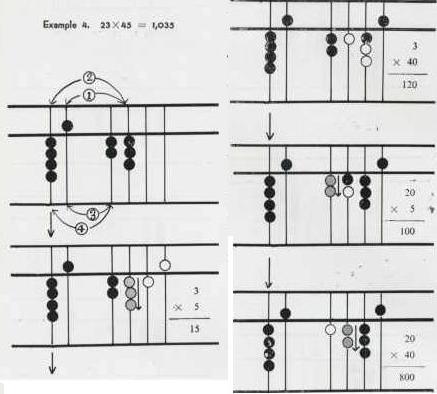
Multiplication is similar to the method used in arithmetic. The multiplication table is used. The multiplicand is set up in the middle of the abacus, and the multiplier at the left. The product is placed to the right of multiplicand, which is removed as soon as multiplied.
Several methods are employed. The following examples are the most common.
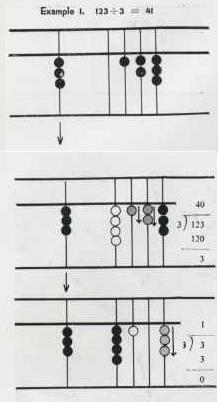
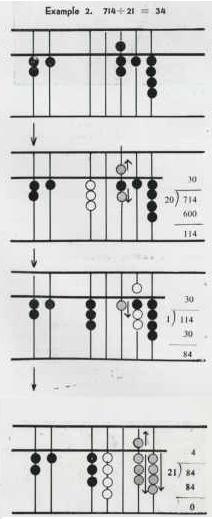
Division proceeds in the reverse order of multiplication. The divided is placed in the middle of the abacus, and divisor to the left. The quotient is placed at the left of dividend.
Speed of the abacus became known to the West after World War II. On November 11, 1946, an abacus competed with an electric computer in Tokyo. Kiyoshi Matsuzaki, 22, a Japanese, manipulated the abacus. Thomas Ian Wood, 22, an American, operated the computer. Matsuzaki defeated Wood in addition, subtraction, and division.
Three days later, another contest was held in New York. P. T. So, a Chinese student of banking at Columbia University, finished an 11-figure calculation with an abacus in 40 seconds. Using a computer, his American opponent required 48 seconds.
In 1959, Prof. Lee Kai-chen defeated electric computers in Seattle and New York competitions. Similar results were reported from London in 1958 and from Taipei several times in recent years.
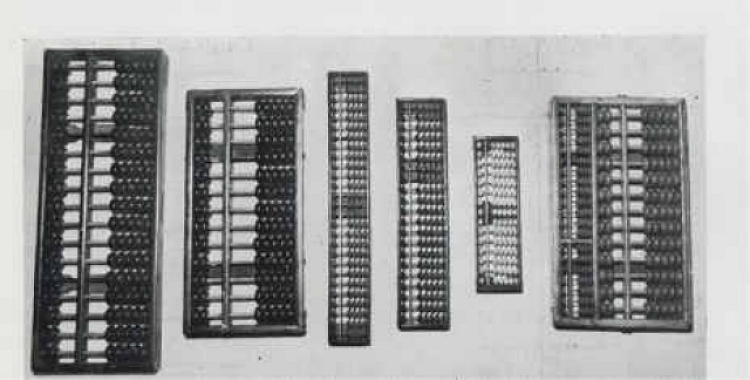
Different models of abacus. Two at the left are Chinese and three in the middle Japanese. At right is the new combination design (File photo)
The most recent contest was held at the Ming Chuan Girls' College of Commerce in Taipei March 25. Two Ming Chuan students defeated six electric computer operators. Kang Su-yi and Chou Pei-kuang of Ming Chuan scored 375 and 335 points. Liu Ti, the fastest computer operator, had only 195.
The abacus has many virtues besides calculating speed. It costs only US$1. School-boys can afford one and most have their own.
An abacus is handy. The operator can lay it in his lap and do his calculations without using pencil or paper. The device can be carried in a brief bag, and there is even a pocket model.
Name of the inventor of this boon to mankind is lost in obscurity. Legend says the abacus, came into use during the time of Huang Ti (2600 B.C.). Other and more probable dates range from 206 B.C. down to 1368 A.D. Historians agree it became popular after Chen Ta-wei, a mathematician of the Ming dynasty, published An Outline of Abacus Counting in 1593.
The earliest type of Chinese abacus seems to have been suanchou, a bundle of bamboo or wooden rods resembling chopsticks. These survived in Korea until the close of the 19th century.
The present model, suanpan (counting tray), was developed during the 14th century. It had one upper and four lower beads. A century later, an additional bead was added to each section. In the late 19th century, some models had three upper beads.
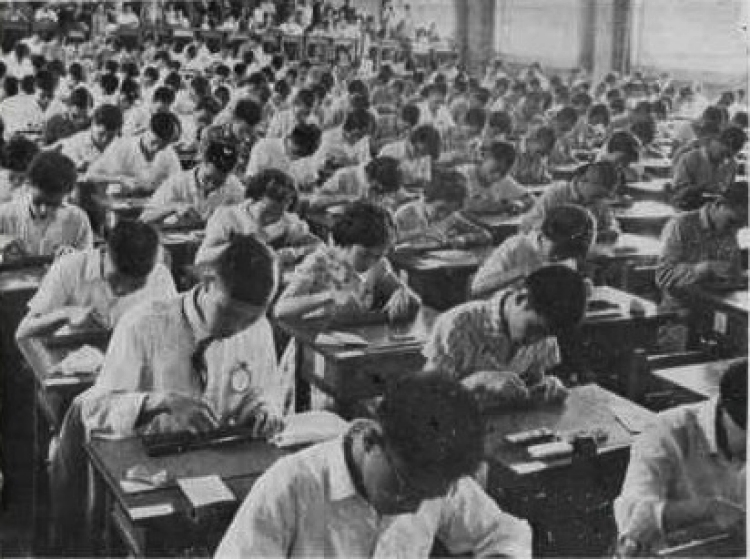
Abacus grading examinations are held once or twice a year. Candidates are commercial school students and bank clerks (File photo)
The suanpan was introduced into Japan, presumably by traders via Nagasaki, during the 15th century. It was remodeled into a six-bead apparatus and caned soroban. A five-bead model was designed in 1938. The counting tray is called chupam in Korea.
In China, Japan, and Korea, abacus calculation is a compulsory subject for students of commerce and home economics. In primary schools, the abacus is used in teaching arithmetic.
Some 50,000 students are receiving four to six hours of abacus instruction a week at 33 commercial and 10 home economics schools in Taiwan. Scholarships are available for those with unusual apitude. Most cities have one or more night schools teaching abacus and accounting to adults. An elementary course lasts four months.
Since 1961, the Chinese Chamber of Commerce has sponsored qualifying examinations in abacus counting once or twice a year. There are no restrictions of age or sex. Candidates are tested in addition, subtraction, multiplication, division, balancing of books, mental addition and subtraction, mental multiplication, and mental division. In mental calculation, most candidates picture an abacus in their mind and manipulate the fingers of their right hand. Those passing the examination are given priority for employment in banking and business establishments.
As in judo, successful examinees are classified into ten grades (the highest) and five steps (the lowest). Taiwan has one abacus operator of fourth grade, five of third grade, three of second grade, and 21 of first grade. About 10,000 persons are progressing through the various steps, from fifth to first. After that comes first grade. Most of the grade holders are bank clerks. The highest ranking is Lin Chao-hsing, a senior student at Provincial Tainan Commercial School. Huang Kuang-tsan, a seven-year-old girl, qualified in the third-step bracket in 1961.
Taiwan has not had an operator of higher than fourth grade. Japanese have attained the seventh grade. As far as is known, no one has scored higher. The grades and their qualifications exist, but no one is that fast.
The first Asian abacus conference was held in Taipei on May 10, 1961. Eleven delegates participated from China, Japan, Korea, Macao, and the Ryukyus. Beginning with 1962, May 10 has been observed as Abacus Day in the Republic of China.
On November 30 of 1962, China, Japan, and Korea set up the International Abacus Association in Tokyo. Overseas Chinese communities in Kowloon, New Zealand, North Borneo, the Philippines, and Thailand sent observers. International contests are held in Taipei, Tokyo, and Seoul from time to time.
The abacus has become the symbol of commerce in Asian countries. Describing the overseas expansion of Japan, a Hongkong merchant recently said: "During the war, the Japanese came to this colony with a rifle in their hands. After the war, they came with an abacus."
In some parts of China, the suanpan helps foretell an infant's future. The baby is shown an abacus and a writing brush. If the tiny hands reach out for the calculating device, a career in business is supposed to beckon.
Popularity of the abacus has been rising in the Western world. Since the 1959 contests in Seattle and New York, Prof. Lee Kai-chen has offered a nine-month correspondence course to thousands of Americans. The United States imports 100,000 abacus calculators from Japan annually. Several elementary and secondary schools of America have found use of the abacus worth teaching.
The compass, gunpowder, and printing from movable type also were invented by the Chinese. All three are universally used. The suanpan has been slower to catch on but now seems on its way to widespread popularity.
Because it really is a better and cheaper "mousetrap," the abacus is beating its way to the doorsteps of the world.
|

